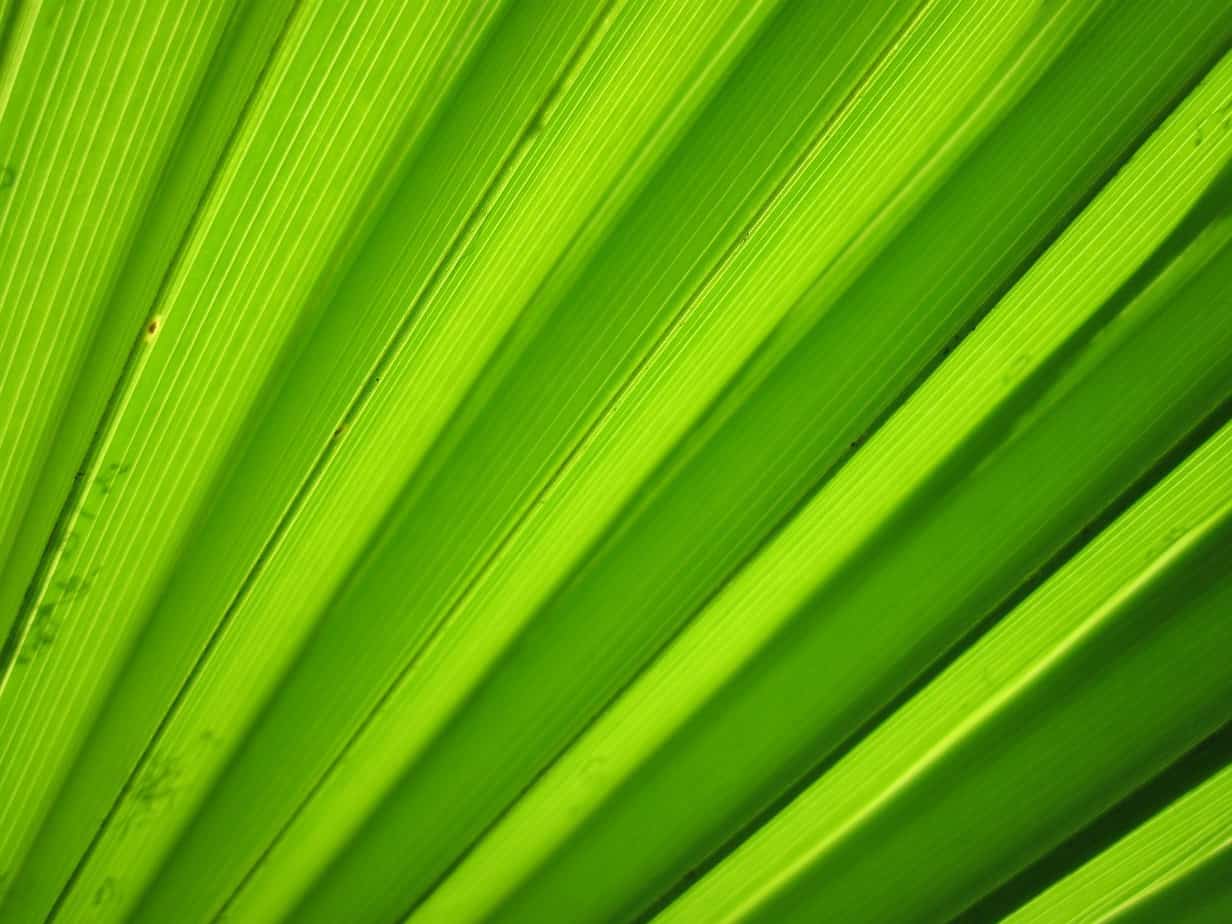Some links in the post are affiliate links and I get a commission from purchases made through some links found in the post.
With more and more people investing in houseplants of every kind, there are a few that are incredibly unique in looks.
They have their ability to transform your home or office into a beautiful green jungle.
Striped leaf plants are among some of the most extraordinary plants to welcome into your space, and they’re pretty easy to take care of, too.
From plants for green connoisseurs, to green thumbs, and even those that are green with envy and struggling to keep a succulent alive.
Here are 10 indoor striped leaf plants that are sure to find their way into your home.
10 Great Striped Leaf Plants to Own
Here are 10 great striped leaf plants for you to enjoy:
1) Calathea
2) Spider Plants
3) Croton
4) Wandering Jew
5) Snake Plant
6) Nerve Plant
7) Dracaena
8) Bromeliads
9) Ti Plant
10) Elephant’s Ear Plant
1) Calathea
Also known as the Zebra Plant or Peacock plant, Calathea are among the most popular houseplants. This is because of how well they thrive indoors, as well as the beauty of their unique leaves.
Calathea is only the general name for this variety of neotropical rhizomatous herbaceous perennial plants. Many Calathea of this genus coming in patterns and colors you could only dream of.
They are perfect for keeping as indoor plants as they do well in low light. Also they will continue to bring beauty to your home for years if well-looked after.
Caring for your Calathea includes making sure they receive proper light in the form of bright, indirect light, but they will do just fine with medium and low light.
Watering should be done every 1 to 2 weeks, depending on the intensity of light. More light means more frequent watering.
They are further perfectly suited for your home as they thrive in temperatures between 65°F and 85°F. Although they should never go below 60°F.
2) Spider Plants
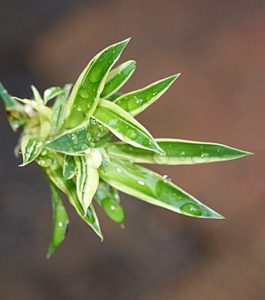 As some of the most low-maintenance indoor plants out there, spider plants offer whimsical décor to your home with their many shoots of pups suspended on long arms, lending the plant its name.
As some of the most low-maintenance indoor plants out there, spider plants offer whimsical décor to your home with their many shoots of pups suspended on long arms, lending the plant its name.
With leaves striped with green, cream and white, you never know what shoots your plant will put out once it matures. You will love watching the variegation appear!
When these pups are big enough, they can be pinched off and repotted. This means your plant can multiply over and over, and you have all the more plants!
Make sure to pot your spider plant in well-draining potting mix, as they don’t like to be too dry or too wet.
They thrive in bright and medium indirect light, but should never be left in direct, hot sunlight, as they will easily burn.
They should be kept in temperatures ranging between 55°F and 80°F, making them an ideal houseplant.
3) Croton
An exotic, tropical houseplant, the Croton is easy to grow, and gorgeous to look at.
With a variety of colorful leaves in differing shapes, their green, red, orange, and yellow leaves change color as the plant matures and is a joy to have in your home throughout.
The Croton likes to be kept moist, but soil must be well-draining to allow for drainage.
If you notice your plant’s soil drying out too fast, you can increase waterings. Also you can occasionally mist the plant to simulate the tropical environment it is used to.
Good sunlight is important to keep its leaves colorful, as too little light will mean new leaves will stay green and prevent it from developing its unique colors.
During the summer, the plant can be left outside, as they thrive on heat. When nighttime temperatures sink below 50°F, the plant should be taken indoors.
4) Wandering Jew
Next, we have the Wandering Jew, a beautiful indoor plant with stripy heart-shaped leaves. It ranges in color from green to purple and they have a silvery sheen.
As a trailing plant, they are ideal for hanging planters, and will look great on a shelf, where its purple or white flowers will be on full display.
The Wandering Jew belongs to the genus Tradescantia, and thrives in bright, indirect sunlight.
Further, the soil should be kept moist, and should be fertilized once a month during its growing season.
When this happens, it’s important to prune back your Wandering Jew as it can get leggy and difficult to take care of.
However, when you do decide to prune it, make sure to keep the cuttings. The cuttings can be easily propagated and made into many new plants!
Ideal temperatures for the Wandering Jew to thrive in are between 50°F and 80°F.
5) Snake Plant
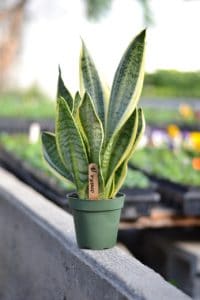 Also known as the Mother-In-Law’s-Tongue plant, the snake plant is a perennial favorite from the Sansevieria family.
Also known as the Mother-In-Law’s-Tongue plant, the snake plant is a perennial favorite from the Sansevieria family.
Some plants have tall, skinny leaves, pushing out new growth in the form of straw-like pups. While other snake plant varieties have shorter, fatter leaves.
Though all varieties of the snake plant have dark green leaves streaked with a yellow outline, and featuring darker green horizontal patterns similar to a watermelon peel.
These striped leaf plants thrive on neglect. This makes them a perfect gifts for first-time plant owners still figuring out how to care for plants. They are great as indoor plants as they don’t need much light.
Further, they are one of the best plants to keep for air purification, helping you to keep the air in your home clean and increasing better sleep and energy.
You should water your snake plant every 2 to 8 weeks, depending on the season and how far away from a light source they are.
You should try to keep them away from an air conditioner, as they like ‘room temperature’.
6) Nerve Plant
Fittonia, ‘Nerve Plant’, or ‘Mosaic Plant’, though incredibly beautiful to look at, is pretty demanding when it comes to care.
They get very dramatic in between watering, which should be done according to a precise schedule. A nerve plant should be kept in a room where they won’t be exposed to cold drafts.
Because they are so demanding, they are best suited to someone with the time to watch them closely each day to check for dry soil and wilting leaves.
When watering these plants, the water should be room temperature to avoid shock to the plant. It requires constant humidity, and must be kept out of direct sunlight as its leaves will quickly burn.
As a trailing plant, they are stunning when left to grow to their full length of around 18 inches, but pruning will help them stay healthy, of course.
They will thrive in a constant temperature of 70°F but will tolerate 60°F – 80°F if all their other needs are met.
7) Dracaena
Here’s a plant for people who like to simulate the jungle inside their homes:
Dracaena, also known as the Dragon Plant or Corn Plant, can grow up to a few feet tall, with its leaves growing to be longer than a foot each.
Like the Snake Plant, Dracaena helps purify the air inside your home, but can also be kept outdoors.
Some Dracaena grow to resemble trees, with their stems becoming sturdy trunks as they mature over time.
They do not need a lot of water, surprisingly, and you can mist their leaves and soil with water, however, their soil should never be soggy.
It’s essential to use purified water when feeding Dracaena.
They are sensitive to fluoride found in tap water. Thier leaves will turn dark brown with yellow edges and die, indicating fluoride poisoning if this happens.
The plant prefers warmer temperatures as it is a tropical plant. Make sure they have a steady light source and are kept away from cold air and drafts will keep them healthy.
A fair warning to pet owners: the plant is toxic to cats and dogs, if eaten, so exercise caution.
8) Bromeliads
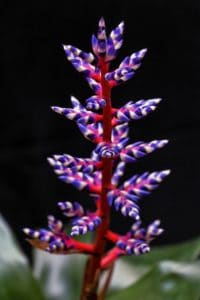 Another tropical beauty with an impressive flower and interesting shape, Bromeliads are popular among houseplant lovers that can’t care for high-maintenance plants.
Another tropical beauty with an impressive flower and interesting shape, Bromeliads are popular among houseplant lovers that can’t care for high-maintenance plants.
Bromeliads are available in many varieties, with leaves and flowers differing per region in terms of flower color, leaf size, and leaf color, and thrive on humidity.
As they are quick to suffer from overwatering, soil should be checked occasionally for dryness. Watering should done into the ‘tube’ that is formed by the plant’s leaves from which the flower grows.
You can watch the water run into all the crevices created by the other leaves – this is how the plant ensures it is evenly watered.
Bright, indirect light is important for Bromeliads and good air flow is essential.
Pups will push out from the soil at the base of the plant and can be repotted as a whole new plant. Keep in mind that a Bromeliad will only flower once in its lifetime!
9) Ti Plant
Boasting brightly colored leaves ranging in color from pink to purple, maroon, yellow, red, brown, and green.
The Hawaiian Ti Plant, or Good Luck Plant, is an impressive addition to any plant lover’s collection.
They are a tropical plant, in which they need humid conditions and bright, indirect light.
The Ti Plant can still successfully be kept indoors if you can simulate these conditions.
They are pretty similar to Dracaena in terms of care; however, the Ti Plant is much fussier and requires close care from an experienced plant lover
Purified water is essential when watering this plant, and the soil should be kept moist, though never soggy, and should never dry out.
Ideal temperatures range between 65°F and 85°F, and the plant should be kept away from cold drafts and hot air.
A humidifier will definitely help with simulating ideal conditions for the Ti Plant. Like the Dracaena, they are also dangerous to dogs and cats.
10) Elephant’s Ear Plant
The Elephant’s Ear plant is also known as the African Mask Plant.
As a hybrid plant of the Amazonica genus, this plant is known for its deeply colored leaves. This is offset by contrasting veins, interesting patterns, and its unique shape resembling an elephant’s ear.
Varieties include the Caladium, Colocasia, Alocasia, and Xanthosoma, each different to the last.
They are relatively easy to care for, needing frequent watering and indirect light. They will also need a humid environment to thrive in as they hail from hot areas.
Rich soil should be kept moist, though never fully saturated, and should never be allowed to dry out.
Elephant Ears with lighter colored leaves can be kept in sunnier places or even full sun. The varieties with darker leaves should be kept in partial or full shade.
Choosing the Perfect Container
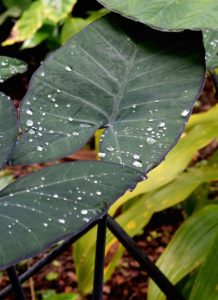
The most important factor to keep in mind when choosing any container to house a plant in is its drainage system.
Most pots come with drainage holes, but in the case of a pot with a solid bottom. You should drill holes into it to ensure proper drainage for your plants to prevent root rot.
It’s always a good idea to repot a plant when you bring it home from the nursery. As plants will often outgrow their nursery pots and become root bound.
Choose a pot that is 1 to 2 inches larger in diameter than their current pot if the current pot is less than 10 inches in diameter.
For pots spanning larger than 10 inches in diameter, you should choose a pot that is 2 to 3 inches larger in diameter.
If your plant requires moist soil, a terracotta pot is a great idea.
As it is made with clay, it retains water, meaning your plant’s soil will be kept moist for longer compared to a pot made of any other material.
If you do choose a decorative pot, make sure to first pot your plant in a plastic nursery pot with drainage holes before placing it into the decorative pot.
Additionally, reusing pots that your plants have come in is a great way to fight plastic waste, and costs you nothing.
Recycled plastic pots are another alternative and can be found at your local nursery.
Final Thoughts: 10 Great Striped Leaf Plants to Own
With all this information in mind, go forth and find the perfect striped leaf plants for your home!
With proper care, they will reward you with a beautiful display that will leave any visitor to your home green with envy!
Before you go, here are some more related articles I encourage you to read below to help solve more of your gardening issues:
Top 15 Houseplants with Red and Green Leaves
Top 10 Best Indoor Floor Plants
What are the Best Oxygenating Plants for Small Wildlife Ponds?

